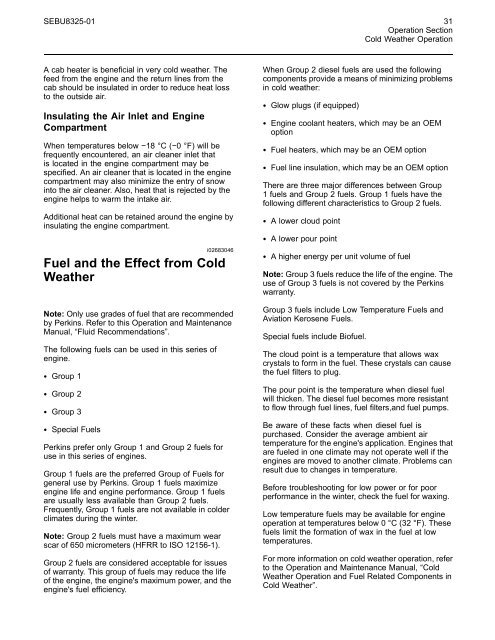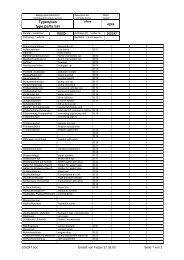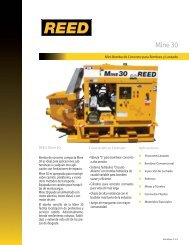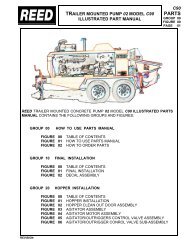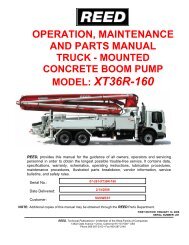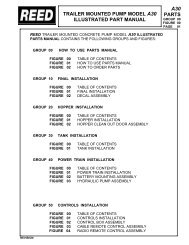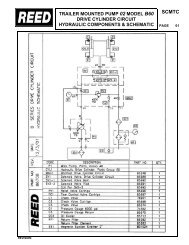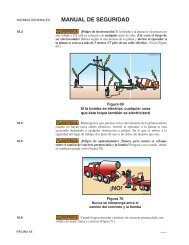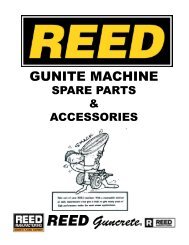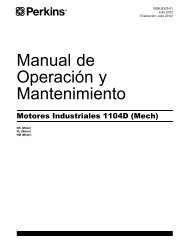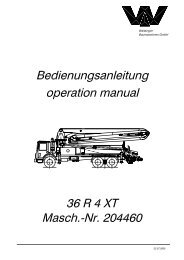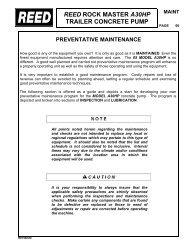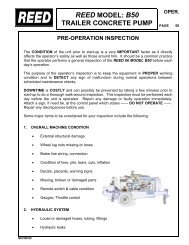Perkins Motor Operation and Maintenance Manual (English) - REED
Perkins Motor Operation and Maintenance Manual (English) - REED
Perkins Motor Operation and Maintenance Manual (English) - REED
You also want an ePaper? Increase the reach of your titles
YUMPU automatically turns print PDFs into web optimized ePapers that Google loves.
SEBU8325-01 31<br />
<strong>Operation</strong> Section<br />
Cold Weather <strong>Operation</strong><br />
A cab heater is beneficial in very cold weather. The<br />
feed from the engine <strong>and</strong> the return lines from the<br />
cab should be insulated in order to reduce heat loss<br />
to the outside air.<br />
Insulating the Air Inlet <strong>and</strong> Engine<br />
Compartment<br />
When temperatures below −18 °C (−0 °F)willbe<br />
frequently encountered, an air cleaner inlet that<br />
is located in the engine compartment may be<br />
specified. An air cleaner that is located in the engine<br />
compartment may also minimize the entry of snow<br />
into the air cleaner. Also, heat that is rejected by the<br />
engine helps to warm the intake air.<br />
Additional heat can be retained around the engine by<br />
insulating the engine compartment.<br />
i02683046<br />
Fuel <strong>and</strong> the Effect from Cold<br />
Weather<br />
Note: Only use grades of fuel that are recommended<br />
by <strong>Perkins</strong>. Refer to this <strong>Operation</strong> <strong>and</strong> <strong>Maintenance</strong><br />
<strong>Manual</strong>, “Fluid Recommendations”.<br />
The following fuels can be used in this series of<br />
engine.<br />
• Group 1<br />
• Group 2<br />
• Group 3<br />
• Special Fuels<br />
<strong>Perkins</strong> prefer only Group 1 <strong>and</strong> Group 2 fuels for<br />
use in this series of engines.<br />
Group 1 fuels are the preferred Group of Fuels for<br />
general use by <strong>Perkins</strong>. Group 1 fuels maximize<br />
engine life <strong>and</strong> engine performance. Group 1 fuels<br />
are usually less available than Group 2 fuels.<br />
Frequently, Group 1 fuels are not available in colder<br />
climates during the winter.<br />
Note: Group 2 fuels must have a maximum wear<br />
scar of 650 micrometers (HFRR to ISO 12156-1).<br />
Group 2 fuels are considered acceptable for issues<br />
of warranty. This group of fuels may reduce the life<br />
of the engine, the engine's maximum power, <strong>and</strong> the<br />
engine's fuel efficiency.<br />
When Group 2 diesel fuels are used the following<br />
components provide a means of minimizing problems<br />
in cold weather:<br />
• Glow plugs (if equipped)<br />
• Engine coolant heaters, which may be an OEM<br />
option<br />
• Fuel heaters, which may be an OEM option<br />
• Fuel line insulation, which may be an OEM option<br />
There are three major differences between Group<br />
1 fuels <strong>and</strong> Group 2 fuels. Group 1 fuels have the<br />
following different characteristics to Group 2 fuels.<br />
• A lower cloud point<br />
• A lower pour point<br />
• Ahigherenergy per unit volume of fuel<br />
Note: Group 3 fuels reduce the life of the engine. The<br />
use of Group 3 fuels is not covered by the <strong>Perkins</strong><br />
warranty.<br />
Group3fuels include Low Temperature Fuels <strong>and</strong><br />
Aviation Kerosene Fuels.<br />
Special fuels include Biofuel.<br />
The cloud point is a temperature that allows wax<br />
crystals to form in the fuel. These crystals can cause<br />
the fuel filters to plug.<br />
The pour point is the temperature when diesel fuel<br />
will thicken. The diesel fuel becomes more resistant<br />
to flow through fuel lines, fuel filters,<strong>and</strong> fuel pumps.<br />
Be aware of these facts when diesel fuel is<br />
purchased. Consider the average ambient air<br />
temperature for the engine's application. Engines that<br />
are fueled in one climate may not operate well if the<br />
engines are moved to another climate. Problems can<br />
result due to changes in temperature.<br />
Before troubleshooting for low power or for poor<br />
performance in the winter, check the fuel for waxing.<br />
Low temperature fuels may be available for engine<br />
operation at temperatures below 0 °C (32 °F). These<br />
fuels limit the formation of wax in the fuel at low<br />
temperatures.<br />
For more information on cold weather operation, refer<br />
to the <strong>Operation</strong> <strong>and</strong> <strong>Maintenance</strong> <strong>Manual</strong>, “Cold<br />
Weather <strong>Operation</strong> <strong>and</strong> Fuel Related Components in<br />
Cold Weather”.


